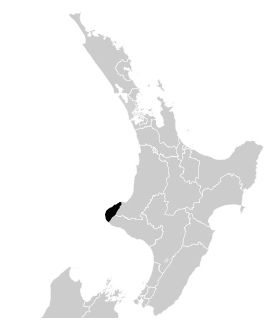Related Research Articles

New Plymouth is a New Zealand parliamentary electorate. It was first created for the 1st New Zealand Parliament in 1853 and has existed since, with one 32-year interruption. The electorate was initially called Town of New Plymouth.
Waipa is a former parliamentary electorate in the Waikato region of New Zealand, which existed for various periods between 1876 and 1996.
Waimarino was a New Zealand parliamentary electorate that existed from 1911 to 1954, and from 1963 to 1972. It was rural in nature and was represented by four Members of Parliament.
Taranaki was a New Zealand parliamentary electorate that existed for three periods between 1881 and 1996. It was represented by nine Members of Parliament.
King Country was a New Zealand parliamentary electorate. It existed from 1972 to 1996 and was represented by Jim Bolger of the National Party for those 24 years.
Franklin was a rural New Zealand parliamentary electorate. It existed from 1861 to 1996 during four periods.
Awarua was a New Zealand parliamentary electorate from 1881 to 1996.
Ohinemuri is a former New Zealand parliamentary electorate. It existed from 1896 to 1928, and was represented by five Members of Parliament.
Stratford is a former parliamentary electorate, in Taranaki, New Zealand. It existed from 1908 to 1946, and from 1954 to 1978. It was represented by six Members of Parliament.
Waitotara was a New Zealand parliamentary electorate in South Taranaki. It existed from 1881 to 1893, and again from 1978 to 1996. It was represented by four Members of Parliament.
Omata was a New Zealand electorate. It was located in Taranaki and based on the township of Omata. One of the original 24 electorates, it existed from 1853 to 1870.
Egmont is a former New Zealand electorate, in south Taranaki. It existed from 1871 to 1978.
Patea is a former New Zealand electorate in south Taranaki. It existed from 1893 to 1963.
Thorndon is a former parliamentary electorate in the city of Wellington, New Zealand from 1881 to 1890.
Waihemo is a former parliamentary electorate in the Otago region of New Zealand. It existed for two periods and was represented by two Members of Parliament.
Mount Ida is a former parliamentary electorate in the Otago region of New Zealand, from 1871 to 1893, and then from 1902 to 1908.
Wellington East was a parliamentary electorate in the eastern suburbs of Wellington, New Zealand from 1887 to 1890 and from 1905 to 1946. It was succeeded by the Miramar electorate. The electorate was represented by seven Members of Parliament.

Courtenay was a parliamentary electorate in Canterbury, New Zealand from 1902 to 1908. The electorate was represented by one Member of Parliament, Charles Lewis.
Hawke's Bay was a parliamentary electorate in the Hawke's Bay Region of New Zealand from 1881 to 1996. In 1986 it was renamed Hawkes Bay.
Felix McGuire was an independent conservative Member of Parliament in New Zealand.
References
- McRobie, Alan (1989). Electoral Atlas of New Zealand. Wellington: GP Books. ISBN 0-477-01384-8.
- Wilson, James Oakley (1985) [First published in 1913]. New Zealand Parliamentary Record, 1840–1984 (4th ed.). Wellington: V.R. Ward, Govt. Printer. OCLC 154283103.